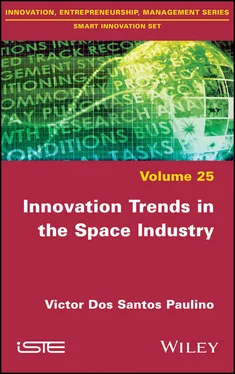Library of Congress Control Number: 2019950868
British Library Cataloguing-in-Publication Data
A CIP record for this book is available from the British Library
ISBN 978-1-78630-491-9
Economic considerations have long remained secondary in space activities. For many years, satellites, space probes, and launchers have been purchased mainly by military customers and space agencies. For these customers, military, political prestige, and scientific considerations predominate. Taking advantage of space technologies to sell a telephone or meteorological service was a marginal objective within space activities.
The end of the Cold War profoundly changed the space industry. It largely contributed to establishing the commercialization of space as a fundamental trend. Although there have been fluctuations since 1990, the weight of economic considerations has continued to increase. Since 2010, it has crossed such a threshold that represents a major challenge for all stakeholders in the industry. For example, developing space technologies by trying first and foremost to take advantage of technological and scientific opportunities becomes dangerous. More emphasis must now be placed on identifying market opportunities.
Faced with this challenge, very little work has placed economic considerations and the transformation of the space industry at the center of their analysis. Space industry stakeholders may, therefore, have difficulty in legitimizing the new weight of economic considerations. The main objective of this book is to fill this gap by proposing a study of the space industry based on innovation management.
We have identified three main issues:
– The space industry was born out of the desire of the Russian and American military to gain an advantage at the beginning of the Cold War. How can we describe the evolution of this industry shaped by customers?
– The space industry produces high-tech products that paradoxically carry few recent electronic components and are developed through processes largely inspired by what was done in the 1950s. How should the conservatism of this high-tech industry be interpreted?
– Small satellites feed the current phase of accelerating the commercialization of space and could be a substitute for traditional satellites built by existing firms. In this context, how can we help existing firms determine whether this technological promise is a threat to be taken seriously or rather a fad?
This book is the result of research conducted since 2003 in the space industry. Since 2013, we have structured our research around the SIRIUS Chair ( www.chaire-sirius.eu). The objective of this chair is to conduct research in management sciences and law applied to the space sector. The SIRIUS Chair also focuses on the dissemination of research and training. We supervise, for the Toulouse Business School, the activities in management science conducted in the SIRIUS Chair.
We would like to thank Dimitri Uzunidis, Honorary President of the Réseau de Recherche sur l’Innovation ( https://rrifr.univ-littoral.fr), for giving us the opportunity to publish this book.

Victor DOS SANTOS PAULINO
October 2019
In 1957, the successful launch of the first artificial satellite, Sputnik 1, led humanity into a new historical period: the space age (McDougall 1982). This new era has given rise to many achievements that have largely gone beyond the scope of space activities. Examples include manned space flights, the Moon landing, and telecommunications satellites. These outcomes are the result of intense innovation efforts guided by the desire to control the space environment, which is poorly known and very different from the terrestrial environment. Space activities have also always been illustrations of what high technology, progress, or a possible future for humanity could be. One thinks in particular of the many science fiction works that are set in the context of life in space and on other planets. In addition to the technological and cultural dimensions, space activities also have a strong military and political significance. The space industry was born out of the desire of the Russian and American military to gain an advantage at the beginning of the Cold War.
For a long time, economic considerations were reduced in the space industry. In institutional markets, competition, prices, and profits were largely dominated by military and political considerations embodied in binding regulations. Examples include the protectionism of defense ministries and space agencies that exclude foreign suppliers from the market. At the beginning of the space conquest, the commercialization of space was not a priority for industry stakeholders. The purpose of putting satellites into orbit was not to sell commercial telecommunications and Earth observation services. However, this situation changed with the end of the Cold War. The commercial market, characterized by international competition and customers seeking to maximize their profits, has grown in size. Conversely, the size of the military and civilian institutional markets has shrunk. The commercialization of space has taken root as a fundamental trend, even if it may have experienced fluctuations. One example is the inflation and then bursting of the “Internet bubble” that impacted the commercial satellite communications market in the second half of the 1990s. We can also mention the acceleration of the commercialization of space that we are currently observing, dubbed “New Space” by industry stakeholders.
With New Space, the commercialization of space has reached a level that gives economic considerations an importance never before achieved. This is a major challenge for industry stakeholders, who must partly redefine space activities in light of these issues. For example, taking into account technological, military, political, and regulatory considerations is increasingly seen as insufficient to ensure the survival of industry stakeholders. Similarly, conducting innovation efforts guided solely by the desire to control the space environment seems dangerous. This effort must now also include the commercialization of innovations. Faced with this new need to take better account of economic considerations, it can be seen that insufficient academic work is available. Some work in history, political science, and law can enlighten industry stakeholders. However, this work is not intended to place economic considerations at the center of their analysis. On the side of economics and management sciences, very little work deals with the space industry and even less with its transformation. The main objective of this book is to fill this gap by proposing a study of the space industry based on innovation management.
In our opinion, three interconnected innovation trajectories must be studied as a priority to understand the commercialization of space. First, it is necessary to describe the long-term evolution of the space industry in light of economic considerations. It then seems essential to us to characterize the innovation strategies of space firms (e.g. Airbus Defence and Space, Boeing, Thales Alenia Space). Finally, we believe it is important to help existing firms to better diagnose the current acceleration of the commercialization of space.
The evolution of the space industry in light of economic considerations
The space industry was born out of the desire of the Russian and American military to gain an advantage at the beginning of the Cold War. How can this type of evolution be described? What role do customers play in this evolution and innovation? Are there any characteristic phases in the dynamics of the space industry?
Читать дальше













